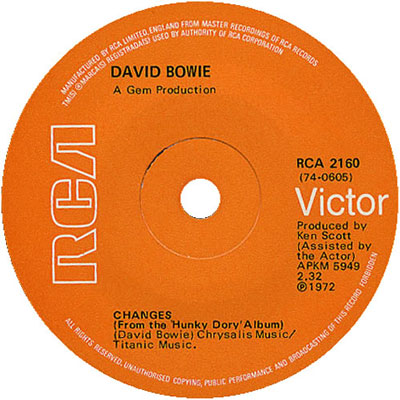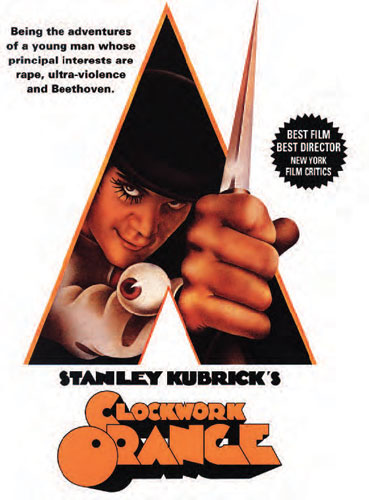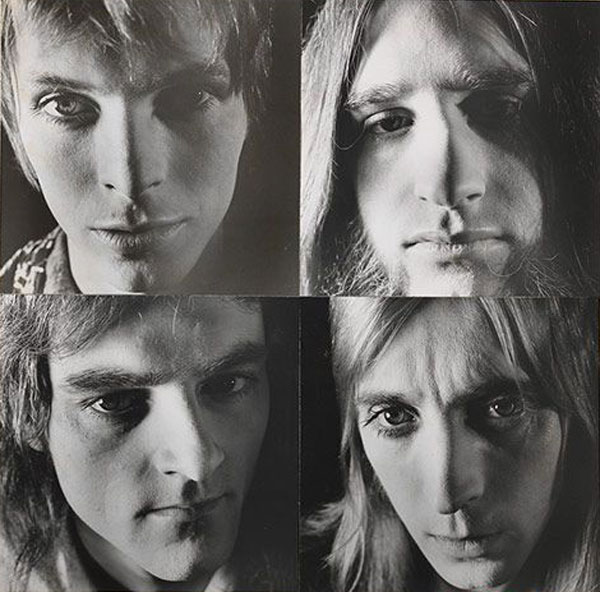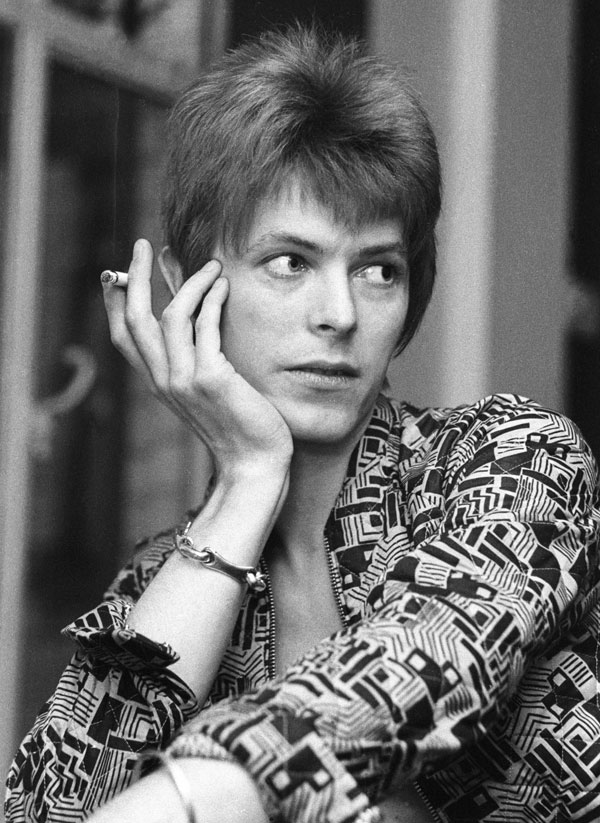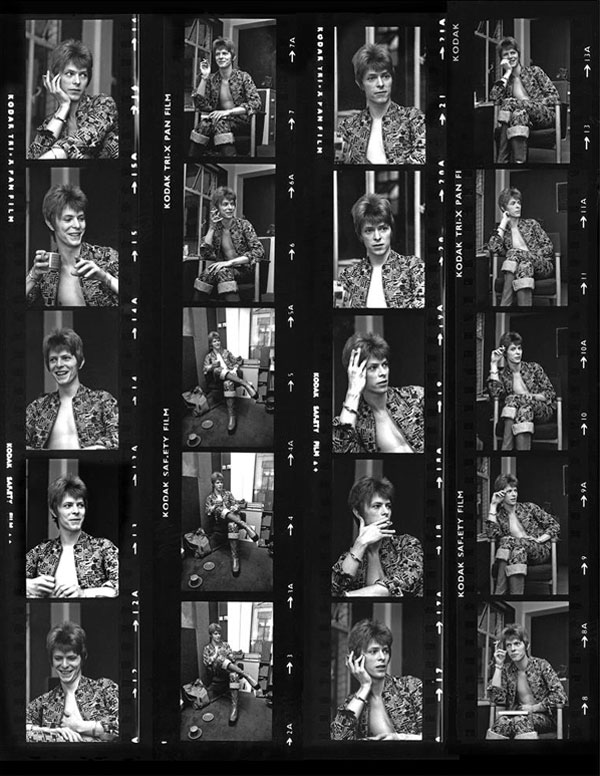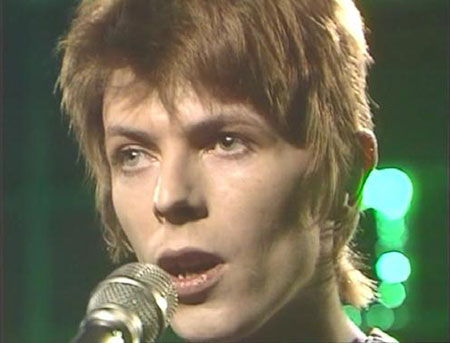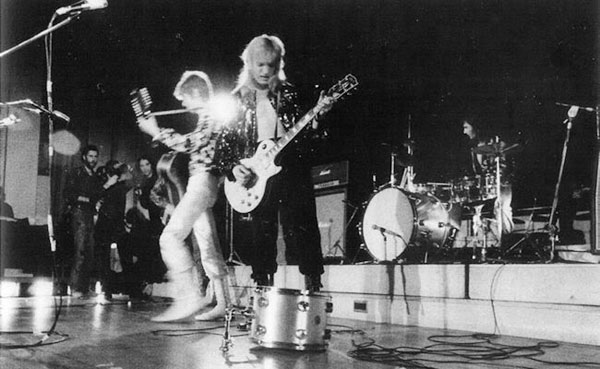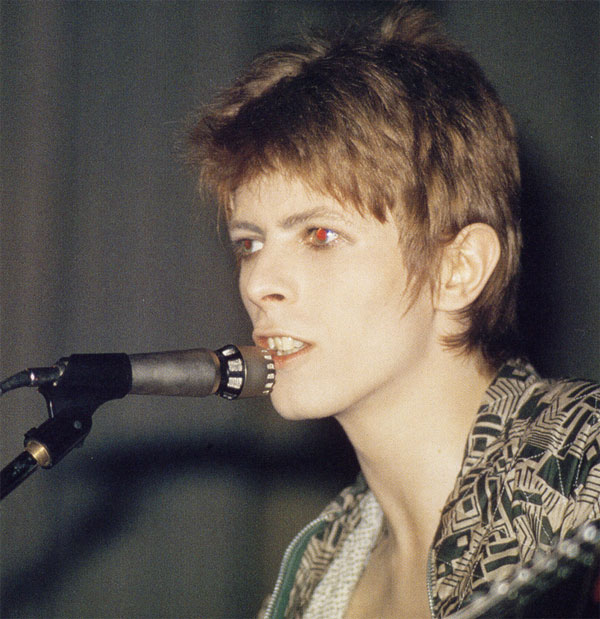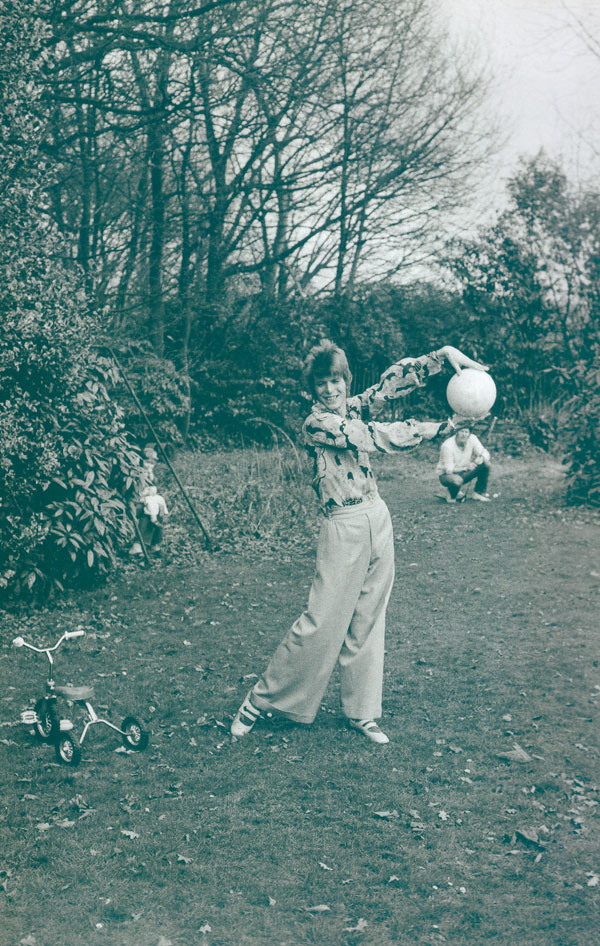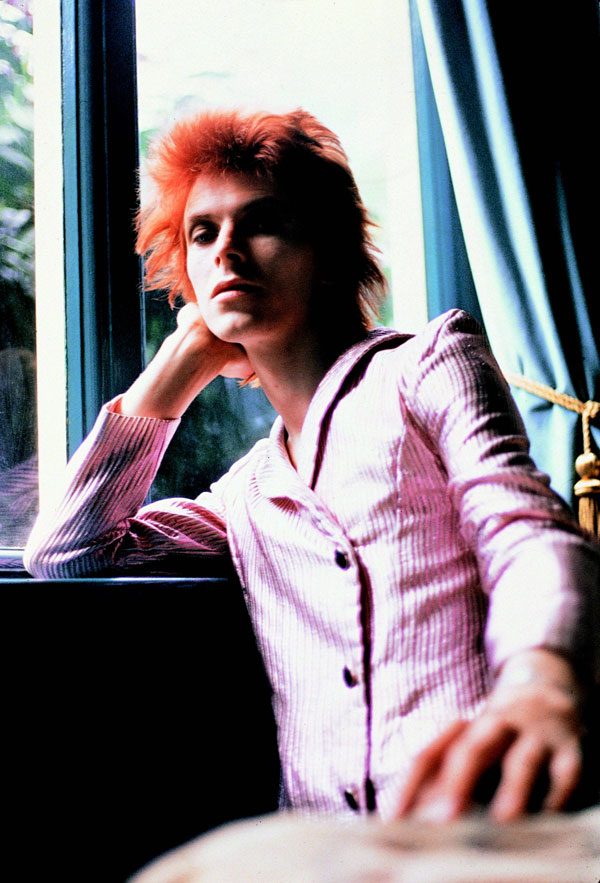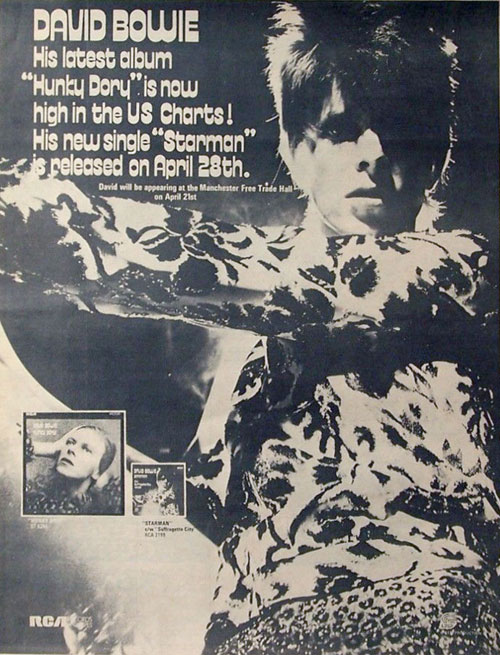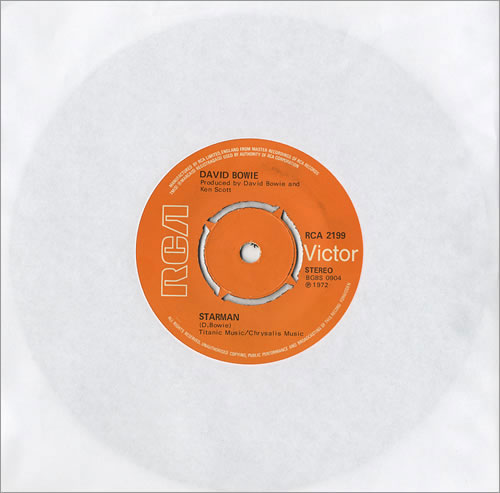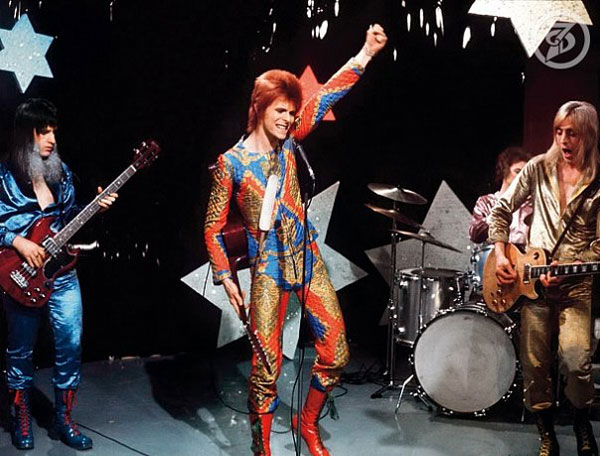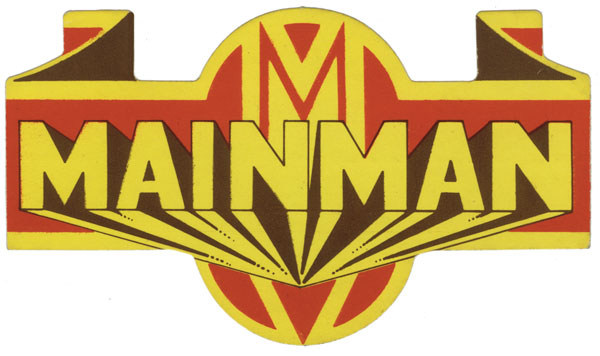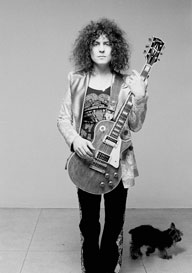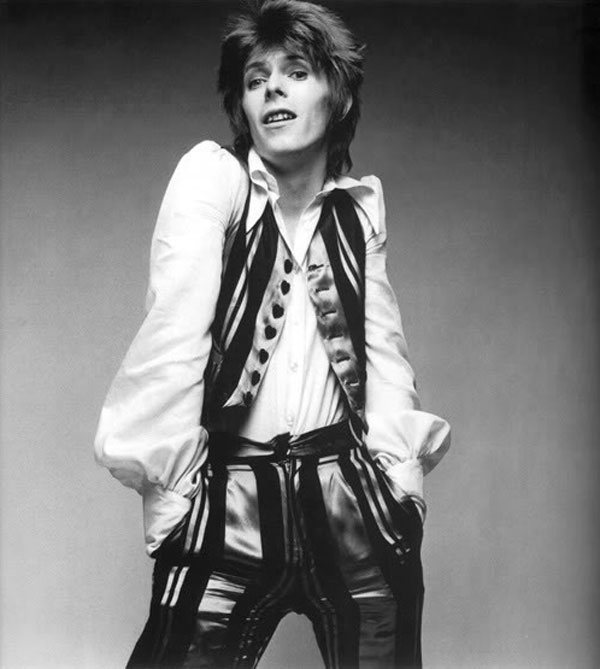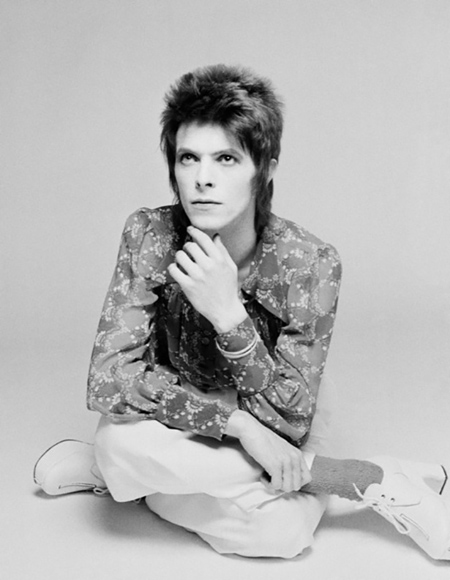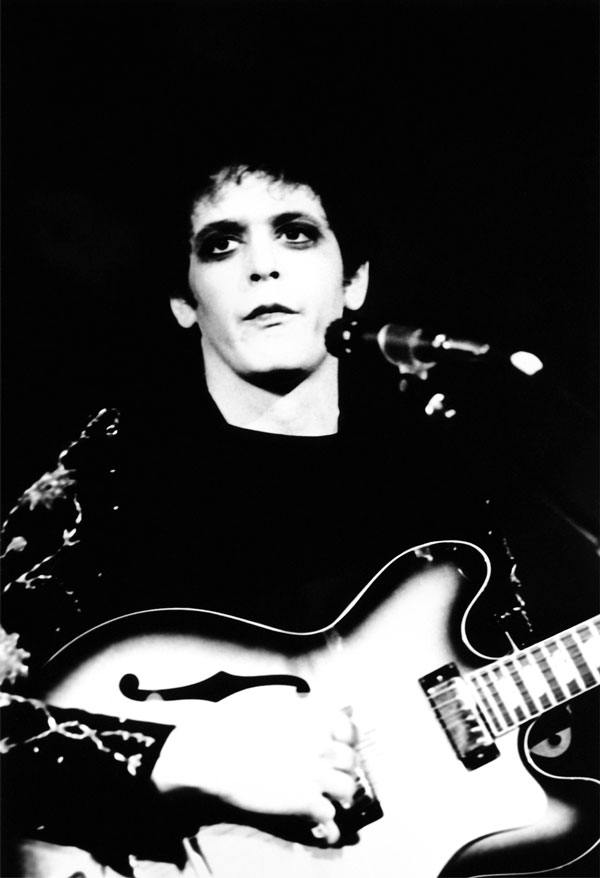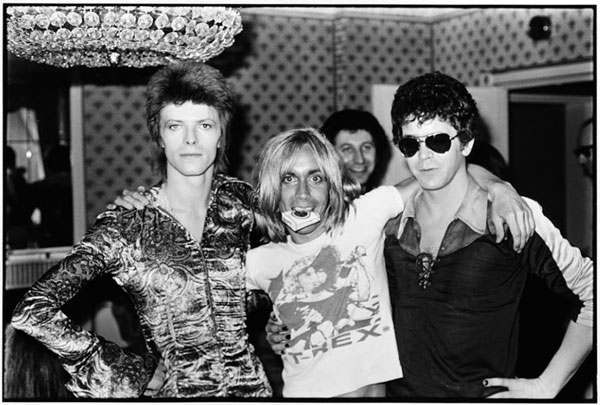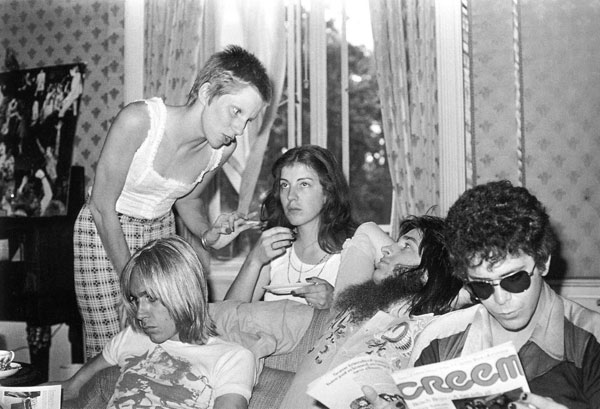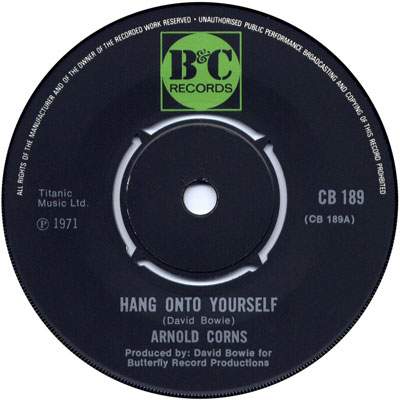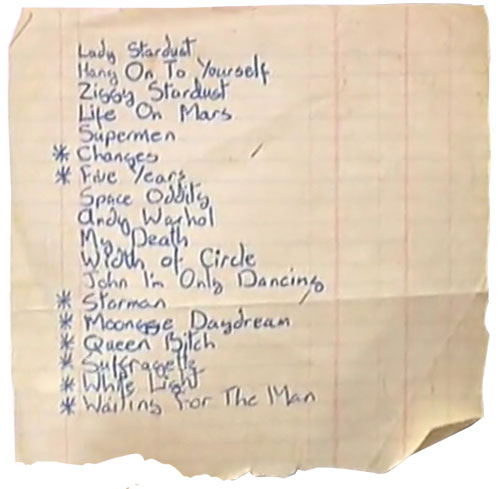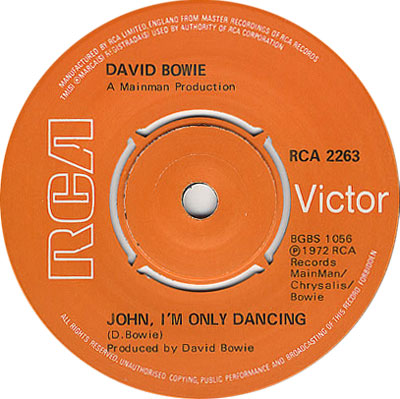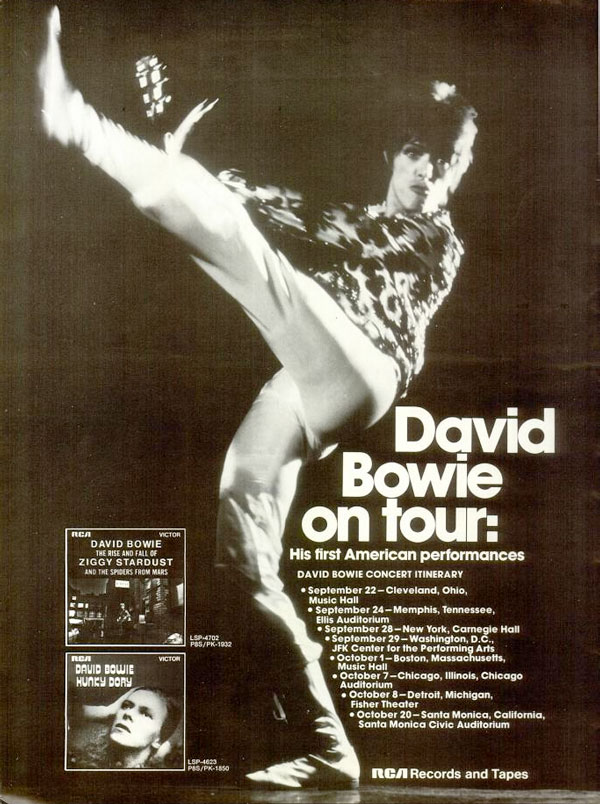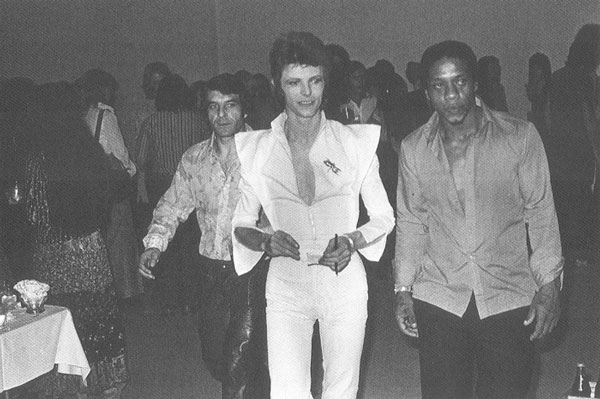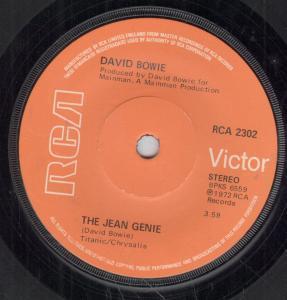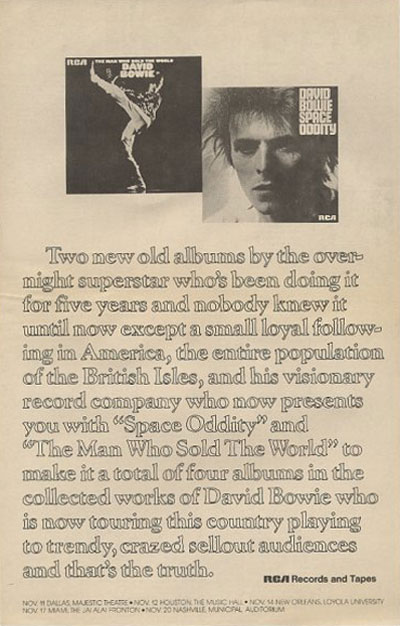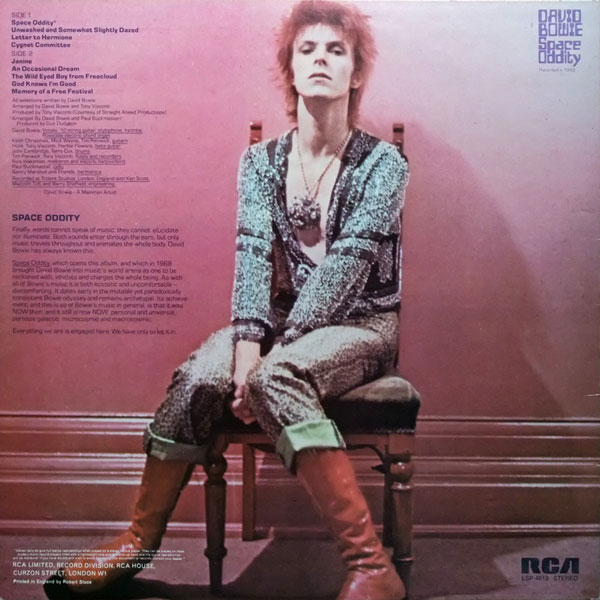1970 • 1971 • 1972 • 1973 • 1974
1975 • 1976 • 1977 • 1978 • 1979 • 1980
THE MAN WHO SOLD THE WORLD • HUNKY DORY
THE RISE AND FALL OF ZIGGY STARDUST
AND THE SPIDERS FROM MARS
ALADDIN SANE • PINUPS • DIAMOND DOGS
YOUNG AMERICANS • STATION TO STATION
LOW • HEROES • LODGER • SCARY MONSTERS
ZIGGY STARDUST THE MOTION PICTURE
THE 1980 FLOOR SHOW • CRACKED ACTOR
THE MAN WHO FELL TO EARTH • THE ELEPHANT MAN
FEATURES • PRESS ARCHIVE
BOWIEGOLDENYEARS is currently being expanded and redesigned
gold page links are live
JANUARY 1972 Angie invited local hairdresser Sue Fussey (later known as Suzi Ronson) to Haddon Hall to work on Bowie's hair, which Fussey said was too “Rod Stewart-ish”. They found inspiration in Alex Chatelain's photos of Christine Walton in the August 1971 Vogue:
Fussey then reshaped Bowie's hair into the familiar Ziggy style. The colour came later. Tuesday January 4 – Thursday January 6 Rehearsals at Underhill Studios, Greenwich Friday January 7
Changes 2:32 • Andy Warhol 3:03
Saturday January 8 Bowie's 25th birthday party at Haddon Hall. Guests included Lou Reed, who was in England recording his debut album, Reed's producer Richard Robinson was also there with his journalist wife Lisa.
Tuesday January 11 Sounds Of The 70s: John Peel Ziggy Stardust Thursday January 13
Clockwork Orange opened at The Warner West End in London. Shortly afterwards Bowie took the band see it and came away with another key element for the Ziggy image.
Mid January Ziggy Stardust album cover
Ward suggested they do more photographs in the street as night was falling, only Bowie was willing. Despite suffering from flu, Bowie ventured out to the street in the drizzling rain, with a guitar he borrowed from Mark Pritchett. Facing the doorway of number 23 Ward shot black and white photos from various angles.
Next door, number 21 was the home of furriers K. West. As Bowie posed beneath their sign, Ward lined up the shot and took four frames, one of which became the front cover.
The K. West sign was removed 20 years later by a fan.
Tuesday January 18 Sounds Of The 70s: Bob Harris Hang On To Yourself • Broadcast: February 7 (Radio One) Wednesday January 19 – Sunday January 23 Rehearsals at Royal Ballroom, Tottenham High Road Saturday January 22 Melody Maker publishes “Oh! You Pretty Thing” – the Michael Watts interview where Bowie told him, "I’m gay, and always have been, even when I was David Jones."
Photos by Barry Wentzell
Sunday January 23 Robert Hilburn's review of Hunky Dory in Los Angeles Times:
Wednesday January 26 – Friday January 28 Rehearsals at Royal Ballroom, Tottenham High Road Saturday January 29 The Friars Club, Borough Assembly Hall, Aylesbury
Photograph © Michael Putland/Getty Images Queen's Roger Taylor and Freddie Mercury were in the audience to witness the rebirth of Bowie, billed as the Most Beautiful Person in the World. The local newspaper proclaimed the next day, “A Star Is Born”. Danny Holloway's review of Hunky Dory in NME:
February 1972 Wednesday February 2 A master tape of the Ziggy album prepared with It Ain’t Easy, Suffragette City and Rock 'N' Roll Suicide replacing Port Of Amsterdam, He’s A Goldmine [Velvet Goldmine] and Holy Holy. RCA’s Dennis Katz had listened to the November 15 acetate of the album and told DeFries that all it needed was a single. Bowie came up with Starman, which replaced Round And Round in the final running order. Friday February 4 Ziggy Stardust album recording sessions Starman
With the last three master takes in the can, the Ziggy Stardust recording sessions were complete. Monday February 7 Old Grey Whistle Test Queen Bitch
One of the booked acts dropped out at the last minute and Bowie was offered the spot. In a small studio, they filmed three songs with Bowie singing live vocals over backing tracks, specially mixed for the performance. Mindful of BBC censorship, Bowie recorded two takes of Oh! You Pretty Things, leaving out the line ‘the earth is a bitch’ on the first. Wednesday February 9
Stereo master reel of Ziggy Stardust side one, showing Round and Round being dropped for the new arrival, Starman. 1972 Ziggy Stardust UK tour David Bowie (vocals, guitar)
Thursday February 10 Toby Jug, Tolworth, South London Friday February 11 Town Hall, High Wycombe Saturday February 12 Great Hall, Imperial College, London
Great Hall, Imperial College • photographs © Ray Stevenson Bowie had recently seen footage of Iggy Pop walking on the crowd's shoulders at the 1970 Cincinnati Pop Festival and tried it out on the Imperial College audience. Unaccustomed to this, they let him tumble to the floor (pictured above). Ever the showman, Bowie recovered and carried on.
Monday February 14 Brighton Dome, Brighton Friday February 18 University of Sheffield Rag Ball, University Park, Sheffield Wednesday February 23 Chichester College, Chichester Thursday February 24 Wallington Public Hall, Wallington, London
Wallington Public Hall • photograph © Dick Barnatt/Redferns Friday February 25 Avery Hill College, Eltham, London Saturday February 26 Happenings, Belfry Hotel, near Sutton Coldfield Monday February 28 Glasgow City Hall, Candleriggs (cancelled) Bowie’s band’s PA was too large for the stage. They refused to play with a smaller system so the show was cancelled. Tuesday February 29 Locarno Ballroom, Sunderland (cancelled) March 1972 Wednesday March 1 Bristol University, Bristol Bowie and the Spiders played to another sparsely attended hall but nevertheless delivered a strong show. Meanwhile DeFries took the completed Ziggy Stardust master tapes and artwork to RCA in New York for approval. Saturday March 4 Gaiety Lounge Show Bar, South Parade Pier, Southsea Tuesday March 7 Yeovil College, Yeovil, Somerset Saturday March 11 Southampton Guild Hall, Southampton Tuesday March 14 Chelsea Village, Glen Fern Road, Bournemouth, Dorset Friday March 17 Town Hall, Birmingham In preparation for the Birmingham show Sue Fussey took the Ziggy hairstyle to its next stage, feathering it. Photographer Mick Rock was covering the show for the Men Only magazine. Before the show, he looked in on the dressing-room and introduced himself. Bowie responded, “I like your name. It can’t be real…” They clicked straight away and Bowie invited him to come back to Beckenham after the show to do the interview. Rock shot his first frames there in the dressing room.
Backstage in Birmingham • photograph © Mick Rock
Birmingham • photograph © Mick Rock On the train back to London, Bowie and Rock found they shared a fascination with outsiders like Iggy Pop, Lou Reed and Syd Barrett, whom Rock befriended at Cambridge and photographed on several occasions including the cover of his album, The Madcap Laughs.
Mick Rock photo session
In the garden at Haddon Hall • photographs © Mick Rock
Friday March 24 Mayfair Ballroom, Newcastle Upon Tyne Monday March 27 Mott The Hoople bass player Pete ‘Overend’ Watts called Bowie to tell him the band would be splitting at the end of their Rock & Roll Circus UK tour.
Bowie met with the band at Gem’s offices to play them the song – All The Young Dudes.
Bowie also offered to produce the single and DeFries offered to add them to the roster of MainMan. Ian Hunter took all the unsigned MainMan contracts to file away at home. Even so, DeFries proceeded to pay off the band’s contract with Island and negotiate a new record deal with CBS. Tuesday March 28 Bowie and Ken Scott remixed Starman for release as the next single. Friday March 31 Bowie’s management contract with Gem renewed for a ten-year term with Bowie receiving £300 a week salary for providing services of “writing lyrics and/or music, composer, arranger, etc”. Bowie signed the document, oblivious to the fact that it made him an employee of DeFries who would be controlling all of Bowie’s revenue. April 1972 Mick Rock photo session Sue Fussey dyed Bowie’s hair red, and the Ziggy hairstyle was complete.
Haddon Hall, April 1972 • photograph © Mick Rock
Haddon Hall, April 1972 • photograph © Mick Rock
Holding the original Hunky Dory artwork in Zowie's room at Haddon Hall, April 1972 • photograph © Mick Rock Sunday April 9 Mott The Hoople at Civic Centre, Guildford
Thursday April 20 The Playhouse, Harlow Friday April 21 Free Trade Hall, Manchester
Tuesday April 25 Interviewed at home by Rosalind Russell for Disc magazine
Haddon Hall, April 1972 • photograph © Michael Putland Photographer Michael Putland arrived at Haddon Hall to find Bowie up a stepladder, painting the ceiling silver (assisted by George Underwood) and decorating the walls with large blue circles. Friday April 28
Starman 4:16 • Suffragette City 3:25 single released in UK
Starman is his first top 10 hit since Space Oddity in 1969. Meanwhile Hunky Dory becomes Bowie’s first album to make the charts, reaching 176 in America. Saturday April 29 Town Hall, High Wycombe (cancelled) Sunday April 30 Guildhall, Plymouth May 1972 Wednesday May 3 Aberystwyth University, Aberystwyth, Wales Saturday May 6 Kingston Polytechnic Main Hall, London Sunday May 7 Hemel Hempstead Pavillion Thursday May 11 Assembly Hall, Worthing Friday May 12 Central London Polytechnic The show inspired Steve Harley to form Cockney Rebel. Saturday May 13 Summer Ball, Slough College, Slough Sunday May 14 Mott The Hoople recording session All The Young Dudes (single) Bowie played rhythm guitar, sang distinctive backing vocals and got everyone (including Stuart George and Nicky Graham) into the studio lavatory to record handclaps for the choruses. Tuesday May 16 Sounds of the 70s: John Peel radio session White Light/White Heat Friday May 19 Oxford Polytechnic, Headington Monday May 22 Johnnie Walker Lunchtime Show radio session Starman Tuesday May 23 Sounds of the 70s: Bob Harris radio session Andy Warhol Bowie and Mott The Hoople celebrated the completion of the All The Young Dudes single at a party that night in London. Thursday May 25 Chelsea Village, Bournemouth Saturday May 27 Ebbisham Hall, Epsom
June 1972 Friday June 2 Newcastle City Hall In the audience – future Smash Hits journalist and Pet Shop Boy Neil Tennant, who later called it as his “favourite gig ever”.
Saturday June 3 Liverpool Stadium Bowie's PA system overloaded the electrical system so Bowie played his acoustic set while the problem was rectified. The power restored, Bowie and the band ended the show with a storming Suffragette City. Sunday June 4 Preston Public Hall Tuesday June 6 St. George’s Hall, Bradford Iggy Pop had kicked heroin and charmed a contract from CBS president Clive Davis for a new Stooges album. He and James Williamson were staying in St John’s Wood at MainMan’s expense they called Ron and Scott Asheton to reunite the Stooges and begin work on their third album, which Bowie was planning to produce. When the brothers arrived in London, Ron was relegated to bass as Williamson had replaced him as Iggy’s guitarist and collaborator in 1971. Wednesday June 7 Sheffield City Hall, reviewed in NME:
Thursday June 8 Middlesbrough Town Hall
Mick Rock’s feature article “David Is Just Not Serious” published in Rolling Stone Friday June 9 London to New York Bowie, DeFries and Ronson flew over for a three-day promotional trip. Their first stop: Elvis Presley at Madison Square Garden.
Lillian Roxon interviewed Bowie at the Helmsley Park Lane Hotel. Bowie also met with Lou Reed to confirm his special guest appearance at Bowie's upcoming benefit concert for Friends of the Earth at the Royal Festival Hall. Tuesday June 13 Bristol Colston Hall
Thursday June 15 Lift Off With Ayshea television appearance
Friday June 16
The Rise And Fall Of Ziggy Stardust album released in UK RCA SF 8287 Chart peak 5 Five Years 4:42 Lady Stardust 3:22
Saturday June 17 Oxford Town Hall During soundcheck Bowie hatched a plan with Mick Ronson, who had been experimenting with stage moves like Hendrix's playing with his teeth.
At the climax of Suffragette City, Mick Rock was ready to capture the moment, then processed the film overnight.
Photograph © Mick Rock Sunday June 18 Mick Rock brought the photograph to DeFries’s office, where Bowie wrote on it in Tippex, “Thanx to all our people for making Ziggy. I love you. Bowie x.” They ran it as a full-page ad in the July 15 issue of Melody Maker. Monday June 19 Southampton Guildhall Wednesday June 21 Friars, Civic Hall, Dunstable Support: The Flamin’ Groovies
Saturday June 24 Recording session at Trident Studios, London John, I’m Only Dancing (two takes) Sunday June 25 Greyhound, Park Lane, Croydon Support: Roxy Music The queue stretched around the block and 1000 people were turned away. PR Dai Davies later issued a press release: “Bowie wishes to apologise … He intends to play another gig as soon as possible." Roxy Music had released their debut album on June 16 and were gaining popularity since their appearance on Old Grey Whistle Test (performing Ladytron) four days after that. Backstage Bowie met their keyboard player Brian Eno for the first time.
Monday June 26 Recording session at
Olympic Studios John, I’m Only Dancing (nine takes) The Spiders were joined by violinist Lindsay Scott who is heard at the end of the choruses, doubling Ronson’s guitar. Bowie chose the entrance hall for its natural reverb to record the handclaps. Thursday June 29 As Starman ascended the UK singles chart, Bowie was invited to perform it on Top Of The Pops, which required a backing tape to accompany his live vocal. Four instrumental takes were recorded.
Friday June 30 Alice Cooper and Roxy Music at Wembley Empire Pool A gig in High Wycombe had been cancelled in mid-June as they were "saturated with gigs that weekend". Bowie, Iggy Pop and Mick Rock opted instead for Alice Cooper’s last UK show, meeting Alice backstage. Tony DeFries changed the name of his company to MainMan Ltd and designed the logo, loosely based on the Superman crest.
July 1972
Producer: David Bowie Saturday July 1 Winter Gardens Pavilion, Weston-super-Mare All was well until the venue received a bomb threat - not uncommon during that time of IRA activity. One concert-goer recalls the evacuation:
Sunday July 2 Rainbow Pavilion, Torquay Wednesday July 5 Top Of The Pops television appearance Starman
Friday July 7 Rehearsals at Underhill Studios, 1 Blackheath Hill, Greenwich Photographer Masayoshi Sukita was in London for a June 30 T.Rex photo session with make-up artist Yasuko (Yacco) Takahashi (below right).
Saturday July 8 Friends of the Earth Save the Whale Benefit Concert Supports: JSD, Marmalade
Seeing the effect Bowie had on his audience, Sukita asked Yacco to arrange a meeting with Tony DeFries to show him his portfolio. He only had his fashion work with him, but DeFries and Mick Rock were impressed and arranged a session with Bowie. DeFries also invited David Bailey and Brian Duffy to create some high-quality studio shots for Bowie’s upcoming US and Japan tour promotion even though they were unfamiliar with Bowie’s work. Photo shoot • Duffy
Photo © Duffy This Duffy session was not used, but Bowie was impressed and asked Duffy back to shoot the cover of Aladdin Sane in January. Thursday July 13 Photo shoot • David Bailey
Photo © David Bailey
Photo shoot • Masayoshi Sukita
Photos © Sukita
Rainbow Theatre foyer with Sukita portrait
Poster © George Underwood Friday July 14 MainMan arranged for RCA to fly in 19 American music journalists including Lillian Roxon, Henry Edwards, Ron Ross, Lisa Robinson, Dave Marsh and Alan Rich for the finale of the first UK Ziggy Stardust tour. Their firsthand reports would prepare American audiences for the coming tour. Dennis Katz arrived in London with the writers who were put up at the Inn On The Park, given cocktails at RCA, then wined and dined at an Italian restaurant. Lou Reed at King’s Cross Cinema Reed took the stage after midnight with a 13 song set, including some VU songs re-recorded for his Lou Reed album.
Mick Rock's coverage of Reed's first UK headline included this shot that Reed chose for Transformer. Saturday July 15 Melody Maker ran the full-page ad featuring Mick Rock’s guitar 'fellatio' shot as the UK Ziggy Stardust tour wound up where it opened in January. Friars Borough Assembly Hall, Aylesbury
photograph © Michael Putland After the concert, followed by the coachload of journalists, Bowie headed back to London to see Iggy's UK debut at King’s Cross Cinema. DeFries had organised it to show off his latest signing to the press. Iggy & the Stooges at King’s Cross Cinema 45 minutes of mayhem that Nick Kent described as "more frightening than all the Alice Coopers and Clockwork Oranges put together, simply because these guys weren’t joking." [Kent, Nick. ‘An initiation into Iggy Pop’ (NME, 29 July 1972)]
Mick Rock's photograph chosen for the cover of Raw Power Sunday July 16 Press conference
The Unholy Trinity ... and Tony DeFries • photos © Mick Rock
Iggy, Angie, Suzi Fussey, Trevor Bolder and Lou Reed reading Creem – perhaps the Lester Bangs article mentioned on the cover:
Monday July 17 London to Cyprus Bowie, Angie, Woodmansey and Bolder left for a two-week holiday in Cyprus. During their stay, Bowie was involved in a head-on collision at a level crossing outside Kyrenia, where they were staying at a coastal resort. Bowie escaped injury but was charged in court with dangerous driving. The charges were dropped after he paid damages for the other car. Friday July 28 All The Young Dudes 3:33 • One Of The Boys (Hunter-Ralphs) 5:35 Mott The Hoople single released in UK Saturday July 29 Revelations - A Musical Anthology For Glastonbury Fayre released The triple album, featuring highlights from the 1971 festival, would have included songs from Bowie’s set but the organisers were denied permission. They surrendered the master tapes to MainMan who lost them. Instead Bowie contributed the Spiders version of The Supermen, recorded during the Ziggy Stardust sessions on November 12. Sunday July 30 Cyprus to London Bowie, Angie, Woodmansey and Bolder flew back to the UK, and were thrown about in the turbulence of an electrical storm. Presciently Bowie had said to Mick Rock in March, “I get worried about dying. At the moment it’s this terrible travel thing. I keep thinking we’re going to crash.” [Rock, Mick. ‘David is just not serious’ (Rolling Stone 110, 8 June 1972)] Bowie would not fly again until 1977. August 1972
Thursday August 10 – Monday August 14 Rehearsals at Rainbow Theatre, London Two shows were scheduled (and sold out) for August 18-19 at the Rainbow Theatre with Lindsay Kemp designing and choreographing the elaborate Ziggy Stardust show. A third show was later added due to demand. Friday August 11 Transformer album sessions Producers: David Bowie and Mick Ronson
Lou Reed had readily agreed to Bowie’s offer to produce Transformer, feeling that he could provide what was lacking from Reed's first album.
Andy’s Chest was a Velvet Underground song that they slowed down and built up with layers of Bowie’s backing vocals. Another Velvets holdover Satellite Of Love was given a similar treatment.
Walk On The Wild Side began as a song Reed had written in 1971 for a play never made so Reed adapted it as an ode to Warhol ‘superstars’.
Saturday August 12 Rehearsals at Rainbow Theatre, Finsbury Park, London Sunday August 13 Mott The Hoople at Civic Hall, Guildford, Surrey Bowie and Reed attended the show with DeFries. Bowie joined the band for All The Young Dudes. Wednesday August 16 Rehearsals at Rainbow Theatre Prior to the first show, keyboardist Nicky Graham was fired by DeFries and, at Ken Scott's suggestion, replaced by Procol Harum’s Matthew Fisher. John, I’m Only Dancing promo film shoot Bowie and the Spiders mimed to a record player hooked up to the PA Mick Rock's original promo, filmed August 19 2017 remake of the promo by Nacho's Videos, incorporating footage from the silent 30 minute 16mm outtakes reel, transferred to video by MainMan in 1995 Saturday August 19 Rainbow Theatre, Finsbury Park, London Programme and poster design: George Underwood The concerts opened with a screening of Un Chien Andalou (resurrected on the 1976 Isolar tour), followed by Ode To Joy, as Bowie emerged from shadows through a cloud of dry ice. Mick Rock filmed the show for his (unreleased) documentary Ziggy Across The Rainbow, including interviews with fans and guests like Elton John.
Bowie backstage and with Lou Reed (top) at the Rainbow Theatre
Hang On To Yourself 2:55 • Man In The Middle 4:10 Saturday August 26 Bowie decided that Lindsay Kemp’s choreography hadn’t worked. They would play the rest of the tour with simpler stage wear and white light. Matthew Fisher was unavailable for the tour so the band was joined by pianist Robin Lumley for tour rehearsals at the Rainbow. Bowie's first choice, Bob Sargeant, was also unavailable but his friend Richie Dharma called Robin Lumley who "jumped at it".
The tour songlist Bowie wrote out for Robin Lumley Sunday August 27 Locarno Centre, Electric Village, Bristol Monday August 28 Rehearsals at Rainbow Theatre, Finsbury Park, London Wednesday August 30 Rainbow Theatre, Finsbury Park, London Thursday August 31 Starkers, Royal Ballrooms, Boscombe, Bournemouth September 1972 Friday September 1 St. Leger Festival, Top Rank Suite, Doncaster
John, I’m Only Dancing 2:43 • Hang On To Yourself 2:38 Saturday September 2 Hardrock Concert Theatre, Stretford, Manchester Over a thousand fans were turned away from the sold-out show, the first concert staged at the newest British purpose-built rock ‘supervenue’.
Manchester • photograph © Mick Rock Sunday September 3 Hardrock Concert Theatre, Stretford, Manchester Monday September 4 Top Rank Suite, Liverpool Tuesday September 5 Top Rank Suite, Sunderland All The Young Dudes single peaked at number 3 in the UK. As Ian Hunter later said, “We got our morale back and decided to keep going.” Wednesday September 6 Top Rank Suite, Sheffield Thursday September 7 Top Rank Suite, Hanley, Stoke-on-Trent Pianist Robin Lumley was not available for the US tour, and auditions failed to find his replacement. Friday September 8
All The Young Dudes Mott The Hoople album released in UK Side one Side two Recorded in May at Trident Studios, and July at Olympic Studios Arranged by Mott The Hoople and David Bowie Sleeve concept/art direction by Mick Rock
Sunday September 10 Southhampton to New York on the QE2 The Bowies and the Underwoods sailed to America with tour companions George and Birgit Underwood. Iggy & the Stooges began four weeks of recording sessions for the Raw Power album at CBS Studios in London. Sunday September 17 New York The Bowies and the Underwoods checked into the Plaza Hotel. RCA's Gustl Breuer joined the entourage to keep an eye on expenditure. Monday September 18 Rehearsals at RCA Recording Studios, New York During rehearsals, auditions were held for pianists for the tour. Ronson suggested Mike Garson who had played on Annette Peacock’s album I’m The One, a current favourite of theirs. Garson's background was jazz/avant-garde, having played with Mel Tormé, Nancy Wilson and Martha Reeves, among others.
Tuesday September 19 New York Dolls at Mercer Arts Centre, Broadway Hotel
Photograph © Bob Gruen Bowie and the Spiders (minus Bolder), Angie, Mick and Sheila Rock met the Dolls – the start of Bowie’s friendship with their singer David Johansen and his girlfriend Cyrinda Foxe. Wednesday September 20 New York to Pennsylvania to Cleveland Throughout the tour, Bowie and a small entourage travelled by chartered coach, train and car. Leee Black Childers and Cherry Vanilla and the rest of the crew would fly ahead who did the rounds of the local media, ensured the records were available in the shops and checked the venues were adequate. Thursday September 21 Rehearsals at Music Hall, Cleveland
1972 US Tour David Bowie (vocals, guitar)
Crew Entourage Friday September 22 Cleveland Music Hall, Cleveland
Cleveland • photographs © John Lynn Kirk/Redferns Saturday September 23 Cleveland to Memphis Along the way, a jam on the bus began with George Underwood playing around with the Yardbirds' I’m A Man and evolved into The Jean Genie. Sunday September 24 Ellis Auditorium (North Music Hall), Memphis After the sold out show they partied at The Memphis Downtowner Inn.
Memphis • photograph © Mick Rock Bowie was interviewed in his hotel room by the local newspaper and Cream. Timothy Ferris reported on the interview for the feature “David Bowie in America” published November 9 – Bowie’s first Rolling Stone cover story. Bowie’s first public performance in America was rapturously received by the ecstatic 3200-strong crowd who rushed the stage at the end of the show. 21-year-old Akron resident Chrissie Hynde went backstage to meet him. She and her friends ended up driving him to dinner in her mother's Oldsmobile Cutlass. "This is a nice car," Bowie observed politely. Wednesday September 27 Press at the Plaza Hotel, New York
Bowie interviewed by Al Aronowitz, whose claim to fame was introducing Bob Dylan to The Beatles in New York. Thursday September 28 Carnegie Hall, New York RCA announced a complete sell-out. MainMan had given away most of the tickets to journalists and New York scenesters like Cyrinda Foxe and Geri Miller. The resulting shortage of tickets ensured Bowie’s New York debut was the hottest ticket in town.
Cyrinda Foxe and Angie at the Plaza suite Friday September 29 ABC news report with interview and Carnegie Hall rehearsal footage. October 1972 Sunday October 1 Music Hall, Boston The concert (like others in New York and Los Angeles) was recorded for a planned live album, which got as far as mixing and cover artwork by George Underwood before being shelved. Monday October 2 Boston to New York Bowie and the tour party travelled to New York to record new material and mix Lou Reed’s Transformer. Wednesday October 4 Recording session
Untitled recordings Friday October 6 Recording session The Jean Genie The Jean Genie was based on jamming the Yardbirds’ I’m A Man on the tour bus a fortnight earlier. After jamming on the riff “as a laugh” in the studio, with a hastily written lyric, the song took shape.
They recorded the track in one take and added overdubs. An hour and a half later it was complete and they had the next single.
New York to Chicago (overnight on the Broadway Ltd) Saturday October 7 Recording session John, I’m Only Dancing Auditorium Theatre, Chicago
Auditorium Theatre, Chicago • photograph © Mick Rock Sunday October 8 Chicago to Detroit by train (on The Wolverine) The Fisher Theatre, Detroit Monday October 9 Detroit to Chicago to St Louis Wednesday October 11 Kiel Auditorium, St Louis Despite the efforts of Leee Black Childers and Cherry Vanilla to drum up publicity, the audience was well below the 10,000 capacity and scattered about in numbered seats.
Thursday October 12 Production at RCA Studio B, Nashville John, I’m Only Dancing Saturday October 14 St Louis to Kansas City by train (on The National Ltd) Sunday October 15 Memorial Hall, Kansas City Concert rescheduled from the 12th at the last minute, resulting in another near empty venue. To make matters worse, Bowie fell off the stage.
Memorial Hall, Kansas City • photo © Mick Rock Monday October 16 Kansas City to Los Angeles by train (aboard Super Chief) This luxury train boasted the Vista Dome observation car, which gave them a panoramic view of the passing scenery. The entourage flew at noon to Los Angeles. At the Beverly Hills Hotel they took conspicuous consumption to the extreme. Tuesday October 17 Los Angeles
In the grounds of the Beverly Hills Hotel • Photo © Mick Rock Mick Rock and Bowie did some test shots for the The Jean Genie film that would “locate Ziggy as a kind of Hollywood street-rat,” with a “consort of the Marilyn brand” – Cyrinda Foxe, who flew over from New York. Geoff MacCormack sent him two bomber jackets from London – dark blue and bright yellow – for the shoot.
Cyrinda Foxe and Bowie in a Beverly Hills bar • photo © Mick Rock Wednesday October 18 Raw Power remixing Bowie spent three days with Iggy remixing the album. Iggy had produced the recording himself but with little studio expertise, found his mixing options were limited and DeFries rejected the result. Iggy then turned to Bowie, hoping to produce something fit for release.
Friday October 20 Santa Monica Civic Auditorium, Los Angeles
Santa Monica Civic Auditorium • photo © Mick Rock This concert was recorded and broadcast live by KMET-FM, giving Bowie invaluable exposure. As the broadcast was good quality stereo, it was quickly bootlegged. It remains the essential 1972 tour document. MainMan was running out of money. Several concerts were poorly attended, in New York they had papered the house, earning nothing. The rising costs threatened the whole tour. DeFries joined the tour in Los Angeles and found the entourage had grown to 46. Concerned about the hangers on they were attracting, he decreed that groupies were to be “sent home without breakfast”. Saturday October 21 Santa Monica Civic Auditorium, Los Angeles The second show was promptly booked and sold out, thanks to radio exposure and Rodney Bingenheimer’s tireless promotion. Friday October 27 The Jean Genie film shoot Director: Mick Rock
photos © Mick Rock Winterland Auditorium, San Francisco Support: Sylvester and his Hot Band, Phlorescent Leech and Eddie Phlorescent Leech and Eddie was ex-Turtles Mark Volman and Howard Kaylan, members of Frank Zappa's Mothers of Invention and drummer Aynsley Dunbar who later played on Pinups and Diamond Dogs.
Saturday October 28 Winterland Auditorium, San Francisco Mick Rock looked at the previous day’s footage and decided they needed more, but they had used the entire budget of $350.
Both Winterland shows were only half full, so they cut their losses and cancelled Dallas and Houston, which were selling slowly. November 1972 Wednesday November 1 Paramount Theatre, Seattle
The Jean Genie 3:59 • Hang On To Yourself 3:35 single released in US Saturday November 4 Celebrity Theatre, Phoenix The trip to Phoenix inspired Bowie to write Drive-In Saturday. With no bookings until New Orleans, the band stayed put, sweltering in the Phoenix heat. Bowie shaved off his eyebrows, like the models in Kansai Yamamoto’s 1971 London fashion show. Wednesday November 8
Transformer Lou Reed album released in US Side one Side two Thursday November 9 Bowie's first Rolling Stone cover published
Friday November 10 RCA reissued Bowie’s Philips/Mercury albums with new artwork, 1972 photos and liner notes. Fine print on the back noted that they were recorded in 1969 and 1970 respectively. Initial pressings included posters of the cover photos and an inner sleeve with lyrics.
Space Oddity RCA LSP 4813
The Man Who Sold The World RCA LSP 4816
promotional EP released in US Space Oddity 3:24 • Moonage Daydream 4:30 Saturday November 11 Majestic Theatre, Dallas (cancelled) Sunday November 12 Music Hall, Houston (cancelled) Tuesday November 14 Layola University, New Orleans Bowie began reworking the song Time, referencing Billy Murcia (‘Billy Dolls’), the New York Dolls drummer who had died November 6. Friday November 17 Pirate’s World Amusement Park, Dania, Miami Charles Shaar Murray reported the audience were more like “religious worshippers at some demonic ceremony than a bunch of people who’ve come together to hear some rock and roll.” George and Birgit Underwood arrived with cover artwork for the planned Ziggy Stardust – US Tour album, having completed it in ten days.
Artwork © George Underwood Monday November 20 Municipal Auditorium, Nashville Wednesday November 22 The Warehouse, New Orleans Friday November 24
The Jean Genie 3:59 • Ziggy Stardust 3:13 Walk On The Wild Side (Reed) 3:37 • Perfect Day (Reed) 3:42 Reed’s ode to the ‘superstars’ of Warhol’s Factory was Reed's first UK hit – the BBC censors missed the line “even when she was giving head”. Saturday November 25 Public Auditorium, Cleveland Tuesday November 28 Stanley Theatre, Pittsburgh Wednesday November 29 Mott The Hoople, Tower Theatre, Philadelphia Bowie introduced the band and joined them for All The Young Dudes and played sax on Honky Tonk Women. Thursday November 30 Tower Theatre, Philadelphia Concert promoter Rick Green introduced Bowie to his aide Pat Gibbons, who would later become Bowie’s acting manager. December 1972 Friday December 1 Tower Theatre, Philadelphia Monday December 4 – Monday December 11 Aladdin Sane album recording sessions
Aladdin Sane Monday December 11 Press conference
Photo © Bob Gruen
Wednesday December 13 Space Oddity promo film shoot
Photo © Mick Rock
After five hours of filming, Mick Rock saw him off on his week-long voyage aboard RHMS Ellinis, where he wrote the lyrics for the song Aladdin Sane.
Thursday December 21 Bowie was welcomed home as a conquering hero, thanks in part to Charles Shaar Murray’s reviews filed from America earlier in the month. Full-page ads in the music weeklies announcing, “Bowie’s Back!” had listed UK tour dates, several of which were already sold out. Saturday December 23 Rainbow Theatre, Finsbury Park, London NME article “Rainbowie” announced Bowie’s first homecoming show, added after the Christmas Eve date had sold out. Bowie, wrote Charles Shaar Murray, “is virtually unassailable”. Sunday December 24 Rainbow Theatre, Finsbury Park, London Charles Shaar Murray’s review of the concert noted the beginnings of Ziggymania, with “young girls reaching out for our hero’s supple limbs and squealing in the customary manner. That American tour has really honed the Spiders to perfection – the show is tougher, flashier and more manic than it’s ever been before.” Presciently Murray added, “Maybe it’s time for Ziggy to retire and for David to usher in the next phase.” [‘Ziggy Pulls The Squealers’ (NME, 6 January 1973)] Thursday December 28 The Hardrock Concert Theatre, Stretford, Manchester Supporting act in Manchester was Fumble, a Fifties revival band who had caught Bowie’s attention. Keyboard player Sean Mayes went on to play on Bowie’s 1978 tour and Lodger. As Bowie was leaving the Hardrock, 13-year old Steven Morrissey wrapped a coin in a piece of paper with his phone number written on it and pushed it through Bowie’s car window. Bowie phoned him – in 1995. Morrissey supported Bowie on that year's Outside tour. Friday December 29 The Hardrock Concert Theatre, Stretford, Manchester A second night was added due to huge public demand, capping a year of almost relentless touring and recording. |
Bowie Golden Years v1.0 created and designed by Roger Griffin 2000
Bowie Golden Years v2.0 2017-2020
Photographs and texts have been credited wherever possible
this page updated June 19, 2023

